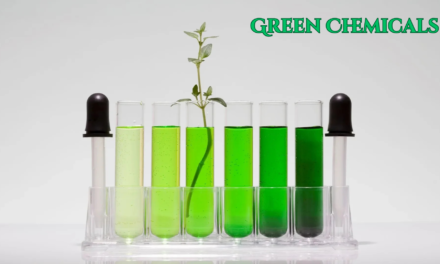Industrial chemicals play a crucial role in the renewable energy sector, facilitating the development, manufacturing, and maintenance of technologies that harness sustainable energy sources. These chemicals are essential for producing solar panels, wind turbines, batteries, biofuels, and hydrogen systems, ensuring efficiency, durability, and scalability. Here’s a detailed overview of their roles across key renewable energy technologies:
1. Solar Energy
- Solar Panel Manufacturing:
- Chemicals are critical for producing photovoltaic (PV) cells, enhancing their efficiency and lifespan.
- Silicon Compounds:
- High-purity silicon, derived from industrial chemicals like trichlorosilane, is used to manufacture crystalline silicon wafers.
- Anti-Reflective Coatings:
- Specialty coatings improve light absorption, increasing solar panel efficiency.
- Etching and Cleaning Agents:
- Acids like hydrofluoric acid and alkaline solutions are used to texture silicon wafers, optimizing light capture.
- Energy Storage Integration:
- Encapsulation materials and adhesives protect PV modules from environmental damage.
2. Wind Energy
- Blade Manufacturing:
- Wind turbine blades require advanced composite materials for strength and flexibility.
- Epoxy Resins and Polyurethane:
- These are used to produce lightweight and durable turbine blades.
- Reinforcing Chemicals:
- Fiberglass and carbon fiber, combined with resins, improve blade performance and longevity.
- Corrosion Protection:
- Anti-corrosion coatings and lubricants protect turbines from harsh environmental conditions, especially in offshore installations.
- Structural Adhesives:
- Used to bond and assemble turbine components, ensuring stability and safety.
3. Energy Storage and Batteries
- Lithium-Ion Batteries:
- Essential for energy storage in solar and wind systems as well as electric vehicles (EVs).
- Electrolytes:
- Lithium hexafluorophosphate (LiPF₆) and other electrolytes ensure efficient ion transport.
- Cathode and Anode Materials:
- Chemicals like lithium carbonate, cobalt compounds, and graphite are used in battery electrodes.
- Separators:
- Specialty polymers and coatings improve battery safety and performance.
- Emerging Battery Technologies:
- Solid-State Batteries:
- Advanced solid electrolytes and conductive polymers are being developed for next-generation batteries.
- Flow Batteries:
- Vanadium and other chemicals enable large-scale, long-duration energy storage.
- Solid-State Batteries:
4. Bioenergy and Biofuels
- Feedstock Processing:
- Chemicals facilitate the conversion of biomass into biofuels like ethanol, biodiesel, and biogas.
- Enzymes and Catalysts:
- Industrial enzymes optimize the breakdown of biomass, while catalysts are used in transesterification for biodiesel production.
- Fermentation Enhancers:
- Nutrient additives improve the efficiency of fermentation processes in ethanol production.
- Fuel Additives:
- Chemicals like antioxidants and stabilizers enhance the quality and storage life of biofuels.
5. Hydrogen Energy
- Hydrogen Production:
- Chemicals are integral to various hydrogen production methods, including electrolysis and steam methane reforming.
- Electrolytes:
- Potassium hydroxide (KOH) and sulfuric acid are used in electrolyzers to produce green hydrogen.
- Catalysts:
- Precious metals like platinum and palladium are key to improving hydrogen production efficiency.
- Hydrogen Storage:
- Ammonia and metal hydrides are used for efficient hydrogen transport and storage.
- Fuel Cells:
- Membrane and electrode materials, often made from industrial polymers and platinum-based catalysts, are critical for hydrogen fuel cell efficiency.
6. Geothermal Energy
- Heat Exchange Fluids:
- Chemicals like brine solutions and advanced heat transfer fluids optimize geothermal energy systems.
- Scale and Corrosion Control:
- Anti-scaling agents and corrosion inhibitors protect pipelines and equipment from mineral buildup and degradation.
7. Advanced Materials for Renewable Systems
- Nanomaterials:
- Nano-coatings and films improve the efficiency of solar cells and energy storage systems.
- Smart Coatings:
- Self-healing and anti-reflective coatings are used in solar panels and wind turbines to enhance durability.
- Thermal Management Materials:
- Chemicals used in phase-change materials and thermal fluids ensure efficient heat management in renewable systems.
8. Role in Sustainability and Recycling
- Recycling Processes:
- Chemicals are essential for recovering valuable materials from end-of-life solar panels, wind turbines, and batteries.
- Examples:
- Hydrochloric acid for silicon recovery from solar panels.
- Hydrometallurgical processes for lithium and cobalt recovery from batteries.
- Life Cycle Improvements:
- Environmentally friendly chemicals reduce the carbon footprint of renewable energy technologies.
9. Environmental and Economic Benefits
- Efficiency Gains:
- Advanced chemicals improve the performance and lifespan of renewable energy systems.
- Cost Reductions:
- Innovations in materials and processes reduce the production costs of renewable technologies.
- Emissions Reduction:
- Chemicals enable the transition to cleaner energy, reducing reliance on fossil fuels.
10. Challenges and Innovations
- Sustainability of Feedstocks:
- Ensuring renewable and sustainable sources for bio-based chemicals and materials.
- Cost of Advanced Materials:
- Developing cost-effective alternatives for rare and expensive materials like platinum and cobalt.
- Scalability:
- Scaling up production of renewable-energy-specific chemicals to meet growing demand.
- Regulatory Compliance:
- Ensuring compliance with environmental regulations for chemical production and usage.
11. Future Trends
- Green Chemistry:
- Developing bio-based and eco-friendly chemicals to support the renewable energy sector.
- Integration with Circular Economy:
- Enhanced focus on recycling and reusing chemicals in renewable energy systems.
- Hybrid Solutions:
- Combining renewable energy technologies with advanced chemical processes for higher efficiency.
Conclusion
Industrial chemicals are fundamental to the growth and success of the renewable energy sector, enabling advancements in solar, wind, hydrogen, bioenergy, and energy storage technologies. As demand for sustainable energy solutions rises, innovations in chemical processes and materials will play a critical role in enhancing performance, reducing costs, and supporting the global transition to a cleaner energy future.
Hashtags
#IndustrialChemicals #ChemicalsInEnergy #ChemicalInnovation #RenewableChemistry #ChemicalsForSustainability #RenewableEnergyApplications #ChemicalsInRenewables #RenewableEnergyMaterials #SolarEnergyChemicals #BatteryChemistry #HydrogenEconomy #TechInEnergy #EnergyChemistryInnovation #SmartChemicalsForEnergy #AdvancedMaterials #ChemicalSolutionsForRenewables #SustainableEnergy #GreenChemicals #EcoFriendlyEnergy #CircularEconomyInEnergy #LowCarbonMaterials #RenewableEnergyMarket

















